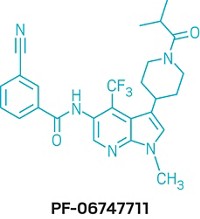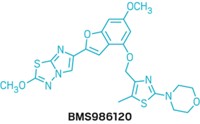Advertisement
Grab your lab coat. Let's get started
Welcome!
Welcome!
Create an account below to get 6 C&EN articles per month, receive newsletters and more - all free.
It seems this is your first time logging in online. Please enter the following information to continue.
As an ACS member you automatically get access to this site. All we need is few more details to create your reading experience.
Not you? Sign in with a different account.
Not you? Sign in with a different account.
ERROR 1
ERROR 1
ERROR 2
ERROR 2
ERROR 2
ERROR 2
ERROR 2
Password and Confirm password must match.
If you have an ACS member number, please enter it here so we can link this account to your membership. (optional)
ERROR 2
ACS values your privacy. By submitting your information, you are gaining access to C&EN and subscribing to our weekly newsletter. We use the information you provide to make your reading experience better, and we will never sell your data to third party members.
Pharmaceuticals
BMS-927711 - Bristol-Myers Squibb
Medicinal chemists debut five drug candidates and describe their discovery.
by Carmen Drahl
April 16, 2012
| A version of this story appeared in
Volume 90, Issue 16

Guanglin Luo, a principal scientist at Bristol-Myers Squibb in Wallingford, Conn., discussed BMS-927711, a potential treatment for migraine that acts at the receptor for calcitonin gene-related peptide (CGRP).
CGRP is a 37-amino-acid neuropeptide that dilates blood vessels. Elevated levels of this peptide have been detected in migraine sufferers’ blood. Blocking the receptor for CGRP, Luo said, counteracts that dilation in cerebral blood vessels without the nonselective blood vessel constriction and resulting cardiovascular risk that’s typical of today’s standard migraine treatment, a class of drugs called triptans.
So far, four CGRP antagonists have reached human clinical trials and have been effective at treating migraines. None of the molecules, however, has made it to market. “The clinical proof-of-concept is there,” but the search for the right molecule continues, Luo said. BMS previously developed the drug candidate BMS-694153 for intranasal administration (J. Med. Chem., DOI: 10.1021/jm800546t). But the company sought a drug that could be taken orally. To reach that goal, BMS chemists swapped a piperidinopiperidine amide in BMS-694153 for a pyridine—a type of exchange known to lead to improvements in oral bioavailability. The swap worked, leading to BMS-846372 (ACS Med. Chem. Lett., DOI: 10.1021/ml300021s). However, BMS-846372 had low aqueous solubility, which could lower its chances of becoming a successful drug. To improve that solubility, the BMS team decided to add polar groups to its molecule, something that’s been tough to do with CGRP inhibitors historically. In the end, the team managed to add a primary amine to BMS-846372’s cycloheptane ring without compromising CGRP activity. This led to BMS-927711.
In marmosets, which experience blood flow changes similar to those that happen during human migraines, BMS-927711 reversed cerebral blood vessel dilation during an induced migraine attack. And in healthy human volunteers, the molecule reached a concentration expected to be effective at migraine treatment in half an hour, Luo reported. BMS-927711 is currently in Phase II clinical trials.





Join the conversation
Contact the reporter
Submit a Letter to the Editor for publication
Engage with us on Twitter